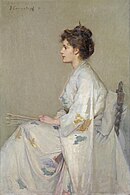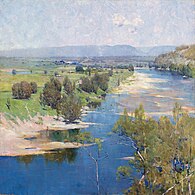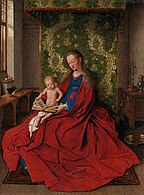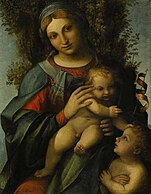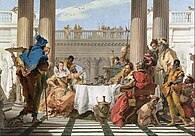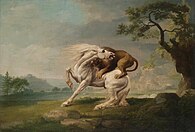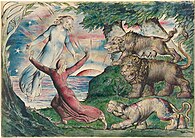Art Bulletin Of Victoria
The NGV houses its collection across two sites: NGV International, located on St Kilda Road in the Melbourne Arts Precinct of Southbank, and the Ian Potter Centre: NGV Australia, located nearby at Federation Square. The NGV International building, designed by Sir Roy Grounds, opened in 1968, and was redeveloped by Mario Bellini before reopening in 2003. It houses the gallery's international art collection and is on the Victorian Heritage Register. The Ian Potter Centre: NGV Australia, designed by Lab Architecture Studio, opened in 2002 and houses the gallery's Australian art collection.
A third site, The Fox: NGV Contemporary, is planned to open in the Melbourne Arts Precinct in 2028, and will be Australia's largest contemporary art gallery.
History
19th century
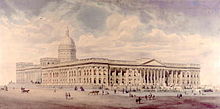
In 1850, the Port Phillip District of New South Wales was granted separation, officially becoming the colony of Victoria on 1 July 1851. In the wake of a gold rush the following month, Victoria emerged as Australia's richest colony, and Melbourne, its capital, Australia's largest and wealthiest city. With Melbourne's rapid growth came calls for the establishment of a public art gallery, and in 1859, the Government of Victoria pledged £2000 for the acquisition of plaster casts of sculpture. These works were displayed in the Museum of Art, opened by Governor Sir Henry Barkly in May 1861 on the lower floor of the south wing of the public Library (now the State Library of Victoria) on Swanston Street. Further money was set aside in the early 1860s for the purchase of original paintings by British and Victorian artists. These works were first displayed in December 1864 in the newly opened Picture Gallery, which remained under the curatorial administration of the Public Library until 1882. Grand designs for a building fronting Lonsdale and Swanston streets were drawn by Nicholas Chevalier in 1860 and Frederick Grosse in 1865, featuring an enormous and elaborate library and gallery, but these visions were never realised.

On 24 May 1874, the first purpose-built gallery, known as the McArthur Gallery, opened in the McArthur room of the State Library, and the following year, the Museum of Art was renamed the National Gallery of Victoria. The McArthur Gallery was only ever intended as a temporary home until the much grander vision was to be realised. However such an edifice did not eventuate and the complex was instead developed incrementally over several decades.
The National Gallery of Victoria Art School, associated with the gallery, was founded in 1867 and remained the leading centre for academic art training in Australia until about 1910. The School's graduates went on to become some of Australia's most significant artists. This later became the VCA (Victorian College of the Arts), which was bought by the University of Melbourne in 2007 after it went bankrupt.
In 1887, the Buvelot Gallery (later Swinburne Hall) was opened, along with the Painting School studios. In 1892, two more galleries were added: Stawell (now Cowen) and La Trobe.
In 1888, the gallery purchased Lawrence Alma-Tadema's 1871 painting The Vintage Festival for £4000, its most expensive acquisition of the 19th century.
20th century

The gallery's collection was built from both gifts of works of art and monetary donations. The most significant, the Felton Bequest, was established by the will of Alfred Felton and from 1904, has been used to purchase over 15,000 works of art.
Since the Felton Bequest, the gallery had long held plans to build a permanent facility; however, it was not until 1943 that the State Government chose a site, Wirth's Park, just south of the Yarra River. £3 million was put forward in February 1960 and Roy Grounds was announced as the architect.
In 1959, the commission to design a new gallery was awarded to the architectural firm Grounds Romberg Boyd. In 1962, Roy Grounds split from his partners Frederick Romberg and Robin Boyd, retained the commission, and designed the gallery at 180 St Kilda Road (now known as NGV International). The new bluestone clad building was completed in December 1967 and Victorian premier Henry Bolte officially opened it on 20 August 1968. One of the features of the building is the Leonard French stained glass ceiling, one of the world's largest pieces of suspended stained glass, which casts colourful light on the floor below. The water-wall entrance is another well-known feature of the building.
In 1997, redevelopment of the building was proposed, with Mario Bellini chosen as architect and an estimated project cost of $161.9 million. The design was extensive, creating all new galleries leaving only the exterior, the central courtyard and Great Hall intact. The plans included doing away with the water wall, but following public protests organised by the National Trust of Victoria, the design was altered to include a new one slightly forward of the original. During the redevelopment, many works were moved to a temporary external annex known as 'NGV on Russell', at the State Library with its entrance on Russell Street.
21st century

A major fundraising drive was launched on 10 October 2000 to redevelop the ageing St Kilda Road building and although the state government committed the majority of the funds, private donations were sought in addition to federal funding. The drive achieved its aim and secured $15 million from the Ian Potter Foundation on 11 July 2000, $3 million from Loti Smorgon, $2 million from the Clemenger Foundation, and $1 million each from James Fairfax and the Pratt Foundation.
NGV on Russell closed on 30 June 2002 to make way for the staged opening of the new St Kilda Road gallery. It was officially opened by premier Steve Bracks on 4 December 2003.
The Ian Potter Centre: NGV Australia in Federation Square was designed by Lab Architecture Studio to house the NGV's Australian art collection. It opened in 2002. As such, the NGV's collection is now housed in two separate buildings, with Grounds' building renamed NGV International.
Locations
St Kilda Road: NGV International
NGV international is located at 180 St Kilda Rd and houses the NGV's European, Asian, Oceanic and American art collections. It houses a number of permanent displays, arranged by region and chronology. It also has a large ground-floor space used for temporary exhibitions, and contemporary art spaces on level 3 are also used for temporary exhibitions. The building is surrounded by a moat and fountains, while the main entrance features a famous water wall, which has been used to display the art of Keith Haring and others. At the rear of NGV International is a sculpture garden, which hosts an annual large-scale installation through the NGV Architecture Commission.
Ian Potter Centre: NGV Australia

NGV Australia is located in the Ian Potter Centre at Federation Square. The building houses the NGV's Australian collection, with a permanent display presenting a chronological history of Australian art and a selection of the galley's 25,000 Australian works. NGV Australia has a particular focus on Indigenous Australian art, and alongside the permanent displays presents temporary exhibitions relating to Australian art and history.
The Fox: NGV Contemporary
In 2018, the State Government of Victoria announced a new contemporary art gallery would be built behind the Arts Centre and the existing NGV International building. The Government spent $203 million to begin the project, including $150 million to purchase the former Carlton and United Breweries building for the new gallery. The new building is part of a major new $1.7 billion redevelopment of the surrounding Melbourne Arts Precinct which is planned to include 18,000 square metres of new public space, new space for contemporary art and design exhibitions, and a new home for the Australian Performing Arts Gallery. The Ian Potter Foundation pledged $20 million for the new building. The masterplan for the precinct was approved in 2022. The public space is being designed by architecture firms HASSELL and SO-IL with a new elevated garden connecting Hamer Hall and Southbank Boulevard.
The winner of the design competition for the NGV Contemporary was announced in March 2022 as Angelo Candalepas and Associates. In April it was announced that billionaires Paula and Lindsay Fox had donated $100 million to the NGV Contemporary project in the largest ever donation to an Australian art museum, and that the gallery would be named The Fox: NGV Contemporary. The new gallery will have 13,000 square metres of exhibition space and is planned to open in 2028. It will be Australia's largest contemporary gallery.
Collection
Asian art

The NGV's Asian art collection began in 1862, one year after the gallery's founding, when Frederick Dalgety donated two Chinese plates. The Asian collection has since grown to include significant works from across the continent.
Australian art
The NGV's Australian art collection encompasses Indigenous (Australian Aboriginal) art and artefacts, Australian colonial art, Australian Impressionist art, 20th century, modern and contemporary art. The first curator of Australian Art was Brian Finemore, from 1960 until his death in 1975.
The 1880s saw the birth and development of the Heidelberg School (also known as Australian Impressionism) in the outer suburbs of Melbourne, and the NGV was well-placed to acquire some of the movement's key artworks, including Tom Roberts' Shearing the Rams (1890), Arthur Streeton's The purple noon's transparent might (1896), and Frederick McCubbin's The Pioneer (1904).
The Australian collection includes works by Del Kathryn Barton, Charles Blackman, Clarice Beckett, Arthur Boyd, John Brack, Angela Brennan, Rupert Bunny, Louis Buvelot, Ethel Carrick, Nicholas Chevalier, Charles Conder, Olive Cotton, Grace Crowley David Davies, Destiny Deacon, William Dobell, Julie Dowling, Russell Drysdale, E. Phillips Fox, Rosalie Gascoigne, John Glover, Eugene von Guerard, Fiona Hall, Louise Hearman, Joy Hester, Hans Heysen, Emily Kame Kngwarreye, George W. Lambert, Sydney Long, John Longstaff, Frederick McCubbin, Helen Maudsley, Tracey Moffatt, Jan Nelson, Hilda Rix Nicholas, Sidney Nolan, John Perceval, Patricia Piccinini, Margaret Preston, Thea Proctor, Hugh Ramsay, David Rankin, Tom Roberts, John Russell, Grace Cossington Smith, Ethel Spowers, Arthur Streeton, Clara Southern, Jane Sutherland, Violet Teague, Jenny Watson, Fred Williams and others.
A large number of works were donated by Dr. Joseph Brown in 2004 which form the Joseph Brown Collection.
Selected works
-
Aboriginal shields
-
The Buffalo Ranges (1864) by Nicholas Chevalier, the first painting of an Australian subject to be acquired by the gallery
-
Tom Roberts, Shearing the Rams, 1890
-
John Longstaff, Lady in Grey, 1890
-
John Russell, Rough Sea, Belle-Île, c. 1900
-
E. Phillips Fox, The Lesson, 1912
-
Clarice Beckett, Evening light, Beaumaris, c. 1925
International art

The NGV's international art collection encompasses European and international paintings, fashion and textiles, photography, prints and drawings, Asian art, decorative arts, Mesoamerican art, Pacific art, sculpture, antiquities and global contemporary art. It has strong collections in areas as diverse as old masters, Greek vases, Egyptian artefacts and historical European ceramics, and contains the largest and most comprehensive range of artworks in Australia.
The international collection includes works by Arbus, Bernini, Bonnard, Bordone, Canaletto, Cézanne, Constable, Correggio, Dalí, Degas, Delaunay, van Dyck, Emin, Gainsborough, Gentileschi, El Greco, Lange, Manet, Matisse, Memling, Modigliani, Monet, Moore, Munch, Picasso, Pissarro, Pittoni, Poussin, Rembrandt, Renoir, Ribera, Riley, Rothko, Rubens, Soulages, Tiepolo, Tintoretto, Titian, Turner, Uccello, Veronese and others.
One of the highlights of the NGV's international collection is Auguste Rodin's first cast of his iconic sculpture The Thinker, executed in 1884. The NGV is also home to the only portrait of Lucrezia Borgia known to have been painted from life, dated to approximately 1515 and attributed to Dosso Dossi.
Selected works
-
Paolo Uccello, St. George Slaying the Dragon, 1430
-
Correggio, Madonna and Child with infant St John the Baptist, 1514–15
-
Rembrandt, Two old men disputing, 1628
-
Thomas Gainsborough, Richard St George Mansergh-St George, 1776
-
John Everett Millais, The Rescue, 1855
-
August Friedrich Schenck, Anguish, 1878
-
Jules Bastien-Lepage, October, 1878
-
Claude Monet, Vétheuil, 1879
-
Paul Cézanne, The Uphill Road, 1881
-
Gustave Caillebotte, The plain of Gennevilliers, yellow fields, 1884
-
Camille Pissarro, Boulevard Montmartre, morning, cloudy weather, 1897
-
Pierre Bonnard, Siesta, 1900
-
Edvard Munch, Early Spring, 1905
-
Amedeo Modigliani, Portrait of the painter Manuel Humbert, 1916
-
Suzanne Valadon, Nude with drapery, 1921
-
Salvador Dalí, Mae West Lips Sofa, 1937
Photography

In 1967, the NGV established the first curatorial department dedicated to photography in an Australian public gallery, one of the first in the world. It now holds over 15,000 works. In that same year, the Gallery acquired the photography collection's first work, Surrey Hills street 1948 by David Moore[1] and in 1969 the first international work was acquired, Nude 1939 by František Drtikol[2]. The first photographer to exhibit solo at the NGV was Mark Strizic in 1968. Jennie Boddington, a filmmaker, was appointed first full-time curator of photography in 1972, possibly only the third such appointment amongst world public institutions.
Prints and drawings
The NGV's Department of Prints and Drawings is responsible for one third of the gallery's collection. Highlights among the department's holdings include one of the world's largest collections of engravings and woodcuts by Dürer. The NGV is also said to have one of the most impressive collections of works by William Blake, including 36 of the 102 watercolours he worked on up until his death in 1827 to illustrate the Divine Comedy by Dante, the largest number of works from this series held by any gallery in the world. Rembrandt and Goya are also well-represented, and the Australian collection contains a detailed account of the history of graphic arts in Australia.
The NGV no longer dedicates a space to exhibiting works from the Prints and Drawings collection, though some works on paper are rotated within the permanent collection galleries and may appear in exhibitions. Works in the collection may be viewed by appointment in the department's Print Study Room.
Selected works
-
Albrecht Dürer, Melencolia I, 1514
-
William Blake, Dante running from the three beasts, 1824
-
J. M. W. Turner, The Red Rigi, 1842
-
Dante Gabriel Rossetti, Paolo and Francesca da Rimini, 1867
-
Ford Madox Brown, The finding of Don Juan by Haidée, 1869
-
Edvard Munch, Towards the Forest II, 1897
Controversies
As a "National Gallery"
When plans for the construction of the National Gallery of Australia in Canberra became firmly established in the 1960s, Australia's state galleries removed the word "national" from their names (for example, the National Gallery of New South Wales in Sydney became the Art Gallery of New South Wales). This naming convention dated back to the 19th century when Australia's colonies were self-governing political entities and had yet to federate. Only the NGV has retained "national" in its name. This has proven to be somewhat contentious, given that the NGV is technically not a national gallery, and occasionally there have been calls for it to follow the example of the other state galleries.



